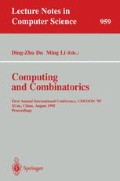Abstract
The complexity of embedding a graph into a variety of topological surfaces is investigated. A new data structure for graph embeddings is introduced and shown to be superior to the previously known data structures. In particular, the new data structure efficiently supports all on-line operations for general graph embeddings. Based on this new data structure, very efficient algorithms are developed to solve the problem “given a graph G and an integer k, construct a genus k embedding for the graph G” for a large range of the integers k and for a large class of graphs.
Supported in part by the United States National Science Foundation grant CCR-9110824 and by a P. R. China HTP-863 grant.
Preview
Unable to display preview. Download preview PDF.
References
Aho, A. V., Hopcroft, J. E., and Ullman, J. D.: The Design and Analysis of Computer Algorithms. Addison-Wesley, (1974)
Chen, J.: A linear time algorithm for isomorphism of graphs of bounded average genus. SIAM J. on Discrete Mathematics 7 (1994) 614–631
Chen, J., Archdeacon, D., and Gross, J. L.: Maximum genus and connectivity. Discrete Mathematics (1995) to appear
Chen, J., Gross, J. L.: Limit points for average genus I. 3-connected and 2-connected simplicial graphs. J. Comb. Theory Ser. B 55 (1992) 83–103
Chen, J., Gross, J. L.: Limit points for average genus II. 2-connected non-simplicial graphs. J. Comb. Theory Ser. B 56 (1992) 108–129
Chen, J., Gross, J. L.: Kuratowski-type theorems for average genus. J. Comb. Theory Ser. B 57 (1993) 100–121
Chen, J. and Kanchi, S. P.: Graph embeddings and graph ear decompositions. Lecture Notes in Computer Science 790 (1994) 376–387
Chen, J., Kanchi, S. P., and Kanevsky, A.: On the complexity of graph embeddings. Lecture Notes in Computer Science 709 (1993) 234–245
Di Battista, G., Eades, P., and Tamassia, R.: Algorithms for automatic graph drawing: an annotated bibliography. Tech. Report (1993) Dept. Computer Science, Brown University
Djidjev, H. and Reif, J.: An efficient algorithm for the genus problem with explicit construction of forbidden subgraphs. Proc. 23rd Annual ACM Symposium on Theory of Computing (1991) 337–347
Filotti, I. S.: An algorithm for imbedding cubic graphs in the torus. Journal of Computer and System Sciences 20 (1980) 255–276
Filotti, I. S., Miller, G. L., and Reif, J. H.: On determining the genus of a graph in O(vO(g)) steps. Proc. 11th Annual ACM Symp. on Theory of Comput. (1979) 27–37
Frederickson, G. N.: Using cellular graph embeddings in solving all pairs shortest paths problems. Proc. 30th IEEE Symp. on Foundations of Computer Science (1989) 448–453
Frederickson, G. N. and Janardan, R.: Designing networks with compact routing tables. Algorithmica 3 (1988) 171–190
Furst, M. L., Gross, J. L., and McGeoch, L. A.: Finding a maximum-genus graph imbedding. Journal of ACM 35-3 (1988) 523–534
Garey, M. R. and Johnson, D. S.: Computers and Intractability: A Guide to the Theory of NP-Completeness. W. H. Freeman, 1979
Gross, J. L. and Furst, M. L.: Hierarchy for imbedding-distribution invariants of a graph. J. Graph Theory 11 (1987) 205–220
Gross, J. L., Tucker, T. W.: Topological Graph Theory. Wiley-Interscience, New York (1987)
Hopcroft, J. E. and Tarjan, R. E.: Efficient planarity testing. Journal of the ACM 21 (1974) 549–568.
Italiano, G. F., La Poutre, J. A., and Rauch, M. H.: Fully dynamic planarity testing in planar embedded graphs. Lecture Notes in Computer Science 726 (1993) 576–590.
Mohar, B.: Projective planarity in linear time. Journal of Algorithms 15 (1993) 482–502
Preparata, F. P. and Shamos, M. I.: Computational Geometry: An Introduction. Springer-Verlag 1985
Tamassia, R.: A dynamic data structure for planar graph embedding. Lecture Notes in Computer Science 317 (1988) 576–590.
Thomassen, C.: The graph genus problem is NP-complete. Journal of Algorithms 10 (1989) 568–576
Author information
Authors and Affiliations
Editor information
Rights and permissions
Copyright information
© 1995 Springer-Verlag Berlin Heidelberg
About this paper
Cite this paper
Chen, J. (1995). Algorithmic graph embeddings. In: Du, DZ., Li, M. (eds) Computing and Combinatorics. COCOON 1995. Lecture Notes in Computer Science, vol 959. Springer, Berlin, Heidelberg. https://doi.org/10.1007/BFb0030829
Download citation
DOI: https://doi.org/10.1007/BFb0030829
Published:
Publisher Name: Springer, Berlin, Heidelberg
Print ISBN: 978-3-540-60216-3
Online ISBN: 978-3-540-44733-7
eBook Packages: Springer Book Archive

